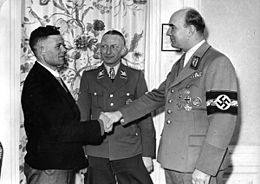Heim ins Reich
Heim ins Reich (që do të thotë "kthehu në shtëpinë e Rajhut; kthehu në Rajh") ishte një politikë e jashtme e ndjekur nga Adolf Hitleri para dhe gjatë Luftës së Dytë Botërore, duke filluar nga viti 1936. Qëllimi i iniciativës së Hitlerit ishte të bindte të gjithë Volksdeutsche (gjermanët etnikë) që jetonin jashtë Gjermanisë naziste (p.sh. në Austri, Çekosllovaki dhe rrethet perëndimore të Polonisë) se ata duhet të përpiqeshin për t'i sjellë këto rajone "në shtëpi" në Gjermaninë e Madhe, por gjithashtu të zhvendoseshin nga territoret që nuk ishin nën kontrollin gjerman, pas pushtimit të Polonisë, në përputhje me paktin nazist-sovjetik.[1] Manifesti i Heim ins Reich synonte zonat e lëshuara në Versajë në shtetin e rilindur të Polonisë, toka të ndryshme imigrimi, si dhe zona të tjera që ishin të banuara nga popullsi të konsiderueshme etnike gjermane, si Sudetenland, Dancig (tani Gdansk) dhe rajonet juglindore dhe verilindore të Evropës pas 6 tetorit 1939.
Zbatimi i politikës u menaxhua nga VOMI (Hauptamt Volksdeutsche Mittelstelle ose "Zyra kryesore e mirëqenies për gjermanët etnikë"). Si një agjenci shtetërore e NSDAP-së, ai trajtoi të gjitha çështjet e Volksdeutsche. Në vitin 1941, VOMI ishte nën kontrollin e SS-ve.[2]
 Polakë të dëbuar në vitin 1939 nga Reichsgau Wartheland.
Polakë të dëbuar në vitin 1939 nga Reichsgau Wartheland. Arthur Greiser duke mirëpritur Volksdeutsche-n e një miliontë të zhvendosur nga Evropa Lindore në Poloninë e pushtuar, mars 1944.
Arthur Greiser duke mirëpritur Volksdeutsche-n e një miliontë të zhvendosur nga Evropa Lindore në Poloninë e pushtuar, mars 1944. Arthur Greiser flet me Volksdeutsche të rivendosur në Lodz në mars 1944
Arthur Greiser flet me Volksdeutsche të rivendosur në Lodz në mars 1944- ^ Tesser, Lynn M. "Europe's pivotal peace projects: Ethnic separation and European integration" (PDF). European Policy Analysis. Swedish Institute for European Policy Studies (Sieps). March 2015 (6). Arkivuar nga origjinali (PDF) më 13 janar 2017. Marrë më 11 janar 2017.
Heim ins Reich, with approximately 600,000 Germans (Volksdeutsche) moving into designated areas [was approved by Hitler, in] a bevy of population exchange agreements in 1938-40 [including] in a 6 October 1939 Reichstag speech.
{{cite journal}}: Mungon ose është bosh parametri|language=(Ndihmë!)Mirëmbajtja CS1: Datë e përkthyer automatikisht (lidhja) - ^ Douglas, R. M. (2012). Orderly and Humane: The Expulsion of the Germans after the Second World War. Yale University Press. fq. 21. ISBN 978-0300183764.
In a keynote address to the Reichstag to mark the end of the 'Polish campaign', Hitler announced on October 6, 1939 ... the Heim ins Reich (Back to the Reich) program. The prospect horrified many ethnic Germans, much of whose enthusiasm for Nazism had been predicated on the expectation that the boundaries of the Reich would, as in the cases of Austria, the Sudetenland, and Danzig, extend to embrace them. The prospect of being uprooted from their homes to face an uncertain future not even in Germany proper, but in the considerably less salubrious environment of western Poland, was much less attractive. So far from rallying enthusiastically to the Führer's call, therefore, many Volksdeutsche greeted the declaration of the Heim in Reich initiative with a deep sense of betrayal.
{{cite book}}: Mungon ose është bosh parametri|language=(Ndihmë!)